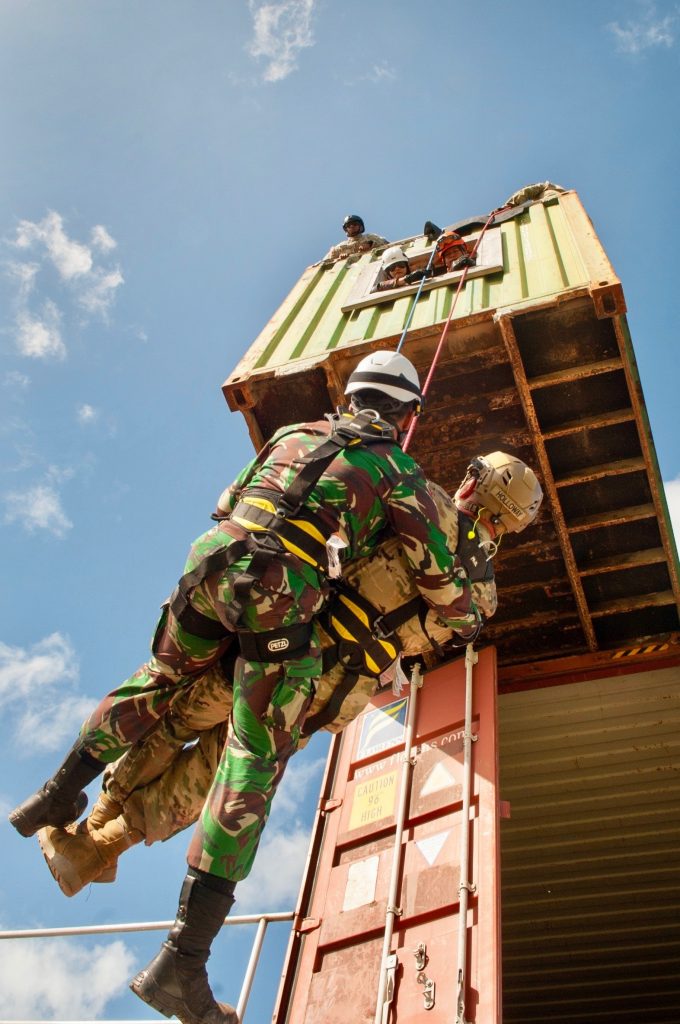Multinational task force practices urban search, rescue at Kalaeloa
Posted on Jul 24, 2019 in In The News154th Wing Public Affairs
Story by Senior Airman John Linzmeier
Wednesday, July 24, 2019
#####

An Indonesian soldier assists a simulated wounded Hawaii Army National Guardsman as he repels from a second story building during a Combined – Multinational Task Force [CTF 501] search and extraction training scenario on July 18, 2019 at Kalaeloa Urban Search and Rescue Training area, Hawaii. Service members from the Philippines, Indonesia, Bangladesh, Vietnam, Oregon Air National Guard traveled to Hawaii as part of a State Partnership Program training event. The CTF 501 aims to increase the amount of trained individuals postured to provide expeditionary response throughout the Asian-Pacific region. (U.S. Air National Guard photo by Master Sgt. Mysti Bicoy)
Teams from Indonesia, Bangladesh, Vietnam, The Philippines, and the Oregon National Guard joined forces with the Hawaii’s CBRNE Enhanced Response Force Package, a Joint Mission comprised of both Army and Air National Guard Soldiers and Airmen. All together, the cohesive unit formed a Combined Multinational Task Force, called CTF 501.
The training activities were held in effort to maintain urban search and rescue standards and revolved around a 24-hour Basic Rope Rescue course, resulting in certifications and an improvement in interoperability.
Civilian responders also played a major role in supporting CTF 501, and regularly participate in disaster response events with the guardsmen, who specialize in scenarios which entail chemical, biological, radiological, nuclear or explosive threats, along with an array of natural disasters which may occur in the region.
Hawaii Army NG Capt. Valentine Roberts, CBRNE Enhanced Response Force Package (CERFP) operations officer, said the four nations were able to overcome obstacles throughout the week, such as language barriers, and further their combined life-saving capabilities.
Much of the initial training was held in a conference-styled setting, where experts could review and discuss emergency response procedures and development of best practices. It also served as a platform to introduce a Multinational Coordination Center, for responses involving humanitarian assistance and disaster relief.
The discussion-based training led up to a disaster scenario, held at Kalaeloa US&R site, which utilized the efforts of all military participants. Instructors focused on life-saving topics, such as pre-incident planning, program safety, rescue philosophy, safety standards and more.
At the training grounds, CTF 501 responders identified possible ‘victim’ locations and recovered causalities from a collapsed structure. Participants exercised rappel techniques to reach confined spaces and used an array of tools to break victims free of concrete confinements and metal obstacles. Simulated personnel with injuries were provided first aid and egressed through litters and a system of ropes.
Each rescue action was carefully evaluated and recorded by a team of instructors, who provided the international operators with feedback, highlighting their strengths and areas of improvement.
Roberts said Service members of all uniforms walked away from the CTF 501 training with more confidence in their rescue abilities and are better prepared to integrate together in the event of potential emergencies.